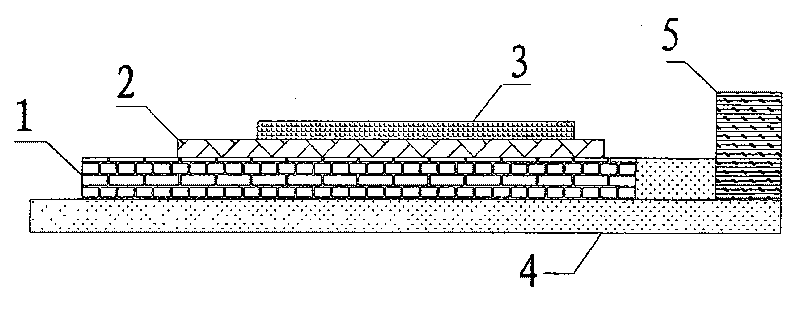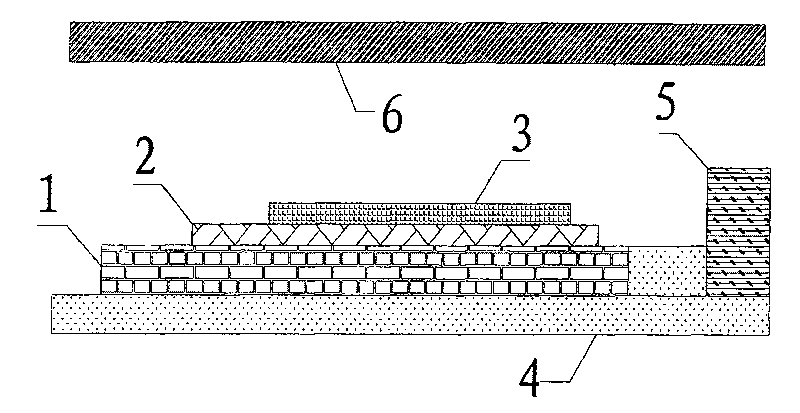Microwave source cathode and manufacturing method therefor
A microwave source and cathode technology, applied in cold cathode manufacturing, electrode system manufacturing, discharge tube/lamp manufacturing, etc., can solve problems such as efficiency affecting the output of microwave sources, short circuit, easy arc generation, etc., and achieve excellent emission and electron emission. Effects of Beam Characteristics
- Summary
- Abstract
- Description
- Claims
- Application Information
AI Technical Summary
Problems solved by technology
Method used
Image
Examples
Embodiment 1
[0027] Embodiment 1: microwave source negative electrode and manufacturing method thereof comprise the following steps: step 1, after mixing 10 grams of four-needle nano-zinc oxide and 100 grams of terpineol in water at 90 degrees Celsius, add an appropriate amount of ethyl cellulose to thicken, and then add 1.1 grams of carbon nanotubes and 2.2 grams of magnesium oxide powder are fully stirred to obtain a slurry; step 2, the slurry in step 1 is printed on the polyacrylonitrile-based activated carbon fiber by screen printing, and the thickness of the slurry is 40 microns; Step 3, as shown figure 2 at 10 -2 After the polyacrylonitrile-based activated carbon fiber in step 2 was baked at a high temperature of 350 degrees Celsius for 3 hours in Pa vacuum, the organic matter in the slurry was decomposed and volatilized, and the method of plasma etching was used to activate the polyacrylonitrile-based activated carbon fiber. Carry out hydrophilic treatment on the carbon fiber surf...
Embodiment 2
[0028] Embodiment 2: microwave source negative electrode and manufacturing method thereof comprise the following steps: Step 1, after mixing 10 grams of four-needle nano-zinc oxide with 1000 grams of terpineol in water at 90 degrees Celsius, add an appropriate amount of ethyl cellulose to thicken, and then add 10.1 grams of carbon nanotubes and 20.2 grams of magnesium oxide powder are fully stirred to obtain a slurry; step 2, the slurry in step 1 is printed on the polyacrylonitrile-based activated carbon fiber by screen printing, and the thickness of the slurry is 400 microns; Step 3, as shown figure 2 at 10 -2 After the polyacrylonitrile-based activated carbon fiber in step 2 was baked at a high temperature of 350 degrees Celsius for 3 hours in Pa vacuum, the organic matter in the slurry was decomposed and volatilized, and the method of plasma etching was used to activate the polyacrylonitrile-based activated carbon fiber. Carry out hydrophilic treatment on the carbon fiber...
Embodiment 3
[0029] Embodiment three: microwave source negative electrode and manufacturing method thereof comprise the following steps: Step 1, after mixing 10 grams of four-needle nano zinc oxide and 500 grams of terpineol in water at 90 degrees Celsius, add an appropriate amount of ethyl cellulose to thicken, and then add 5.1 grams of carbon nanotubes and 10.2 grams of magnesium oxide powder are fully stirred to obtain a slurry; step 2, the slurry in step 1 is printed on polyacrylonitrile-based activated carbon fibers by screen printing, and the thickness of the slurry is 200 microns; Step 3, as shown figure 2 at 10 -2 After the polyacrylonitrile-based activated carbon fiber in step 2 was baked at a high temperature of 350 degrees Celsius for 3 hours in Pa vacuum, the organic matter in the slurry was decomposed and volatilized, and the method of plasma etching was used to activate the polyacrylonitrile-based activated carbon fiber. Carry out hydrophilic treatment on the carbon fiber s...
PUM
| Property | Measurement | Unit |
|---|---|---|
| ignition point | aaaaa | aaaaa |
| thickness | aaaaa | aaaaa |
| thickness | aaaaa | aaaaa |
Abstract
Description
Claims
Application Information
 Login to view more
Login to view more - R&D Engineer
- R&D Manager
- IP Professional
- Industry Leading Data Capabilities
- Powerful AI technology
- Patent DNA Extraction
Browse by: Latest US Patents, China's latest patents, Technical Efficacy Thesaurus, Application Domain, Technology Topic.
© 2024 PatSnap. All rights reserved.Legal|Privacy policy|Modern Slavery Act Transparency Statement|Sitemap



